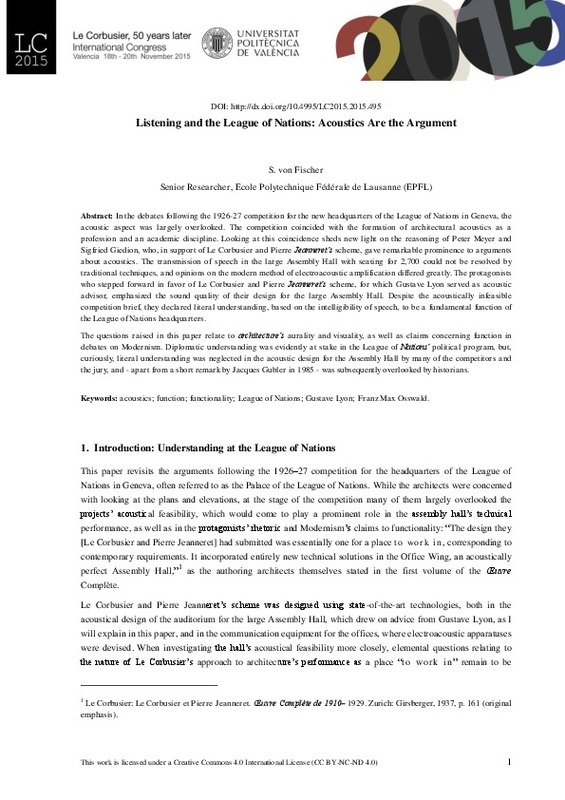JavaScript is disabled for your browser. Some features of this site may not work without it.
Buscar en RiuNet
Listar
Mi cuenta
Estadísticas
Ayuda RiuNet
Admin. UPV
Listening and the League of Nations: Acoustics Are the Argument
Mostrar el registro sencillo del ítem
Ficheros en el ítem
| dc.contributor.author | von Fischer, Sabine
|
es_ES |
| dc.date.accessioned | 2017-09-08T09:14:55Z | |
| dc.date.available | 2017-09-08T09:14:55Z | |
| dc.date.issued | 2016-03-03 | |
| dc.identifier.isbn | 9788490483732 | |
| dc.identifier.uri | http://hdl.handle.net/10251/86803 | |
| dc.description.abstract | [EN] In the debates following the 1926-27 competition for the new headquarters of the League of Nations in Geneva, the acoustic aspect was largely overlooked. The competition coincided with the formation of architectural acoustics as a profession and an academic discipline. Looking at this coincidence sheds new light on the reasoning of Peter Meyer and Sigfried Giedion, who, in support of Le Corbusier and Pierre Jeanneret’s scheme, gave remarkable prominence to arguments about acoustics. The transmission of speech in the large Assembly Hall with seating for 2,700 could not be resolved by traditional techniques, and opinions on the modern method of electroacoustic amplification differed greatly. The protagonists who stepped forward in favor of Le Corbusier and Pierre Jeanneret’s scheme, for which Gustave Lyon served as acoustic advisor, emphasized the sound quality of their design for the large Assembly Hall. Despite the acoustically infeasible competition brief, they declared literal understanding, based on the intelligibility of speech, to be a fundamental function of the League of Nations headquarters. The questions raised in this paper relate to architecture’s aurality and visuality, as well as claims concerning function in debates on Modernism. Diplomatic understanding was evidently at stake in the League of Nations’ political program, but, curiously, literal understanding was neglected in the acoustic design for the Assembly Hall by many of the competitors and the jury, and - apart from a short remark by Jacques Gubler in 1985 - was subsequently overlooked by historians. | es_ES |
| dc.language | Inglés | es_ES |
| dc.publisher | Editorial Universitat Politècnica de València | es_ES |
| dc.relation.ispartof | LE CORBUSIER. 50 AÑOS DESPUÉS | es_ES |
| dc.rights | Reconocimiento - No comercial - Sin obra derivada (by-nc-nd) | es_ES |
| dc.subject | architecture | es_ES |
| dc.subject | le corbusier | es_ES |
| dc.subject | modern movement | es_ES |
| dc.title | Listening and the League of Nations: Acoustics Are the Argument | es_ES |
| dc.type | Capítulo de libro | es_ES |
| dc.type | Comunicación en congreso | es_ES |
| dc.identifier.doi | 10.4995/LC2015.2015.495 | |
| dc.rights.accessRights | Abierto | es_ES |
| dc.description.bibliographicCitation | Von Fischer, S. (2016). Listening and the League of Nations: Acoustics Are the Argument. En LE CORBUSIER. 50 AÑOS DESPUÉS. Editorial Universitat Politècnica de València. 694-712. https://doi.org/10.4995/LC2015.2015.495 | es_ES |
| dc.description.accrualMethod | OCS | es_ES |
| dc.relation.conferencename | LC2015 - Le Corbusier, 50 years later | es_ES |
| dc.relation.conferencedate | November 18-20,2015 | es_ES |
| dc.relation.conferenceplace | Valencia, Spain | es_ES |
| dc.relation.publisherversion | http://ocs.editorial.upv.es/index.php/LC2015/LC2015/paper/view/495 | es_ES |
| dc.description.upvformatpinicio | 694 | es_ES |
| dc.description.upvformatpfin | 712 | es_ES |
| dc.type.version | info:eu-repo/semantics/publishedVersion | es_ES |
| dc.relation.pasarela | OCS\495 | es_ES |








